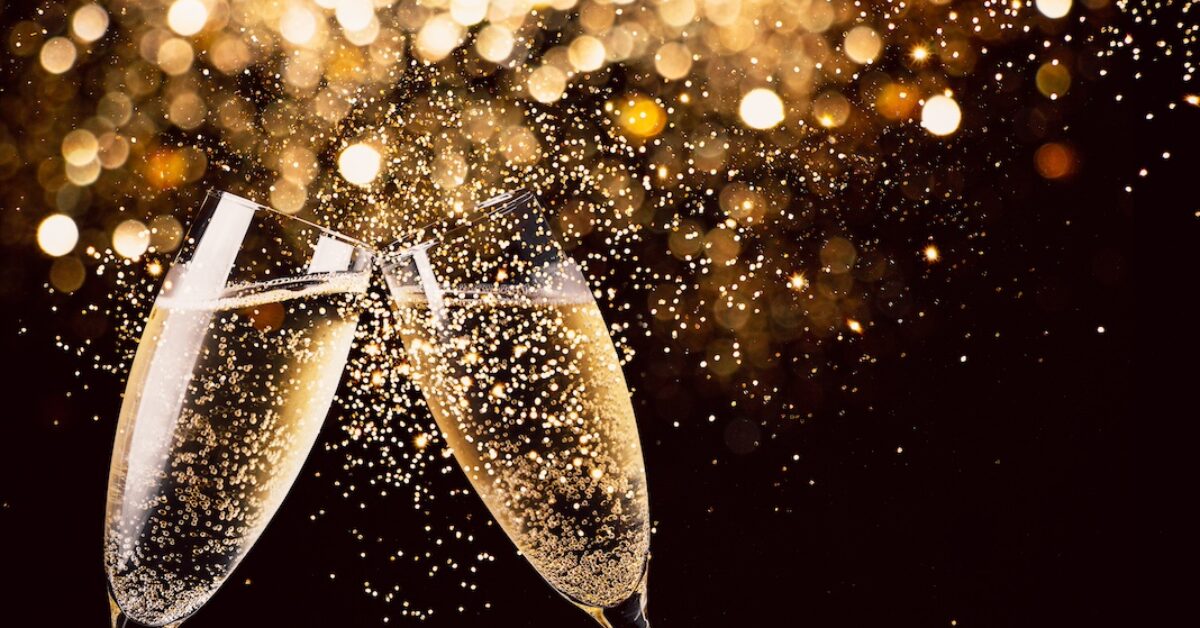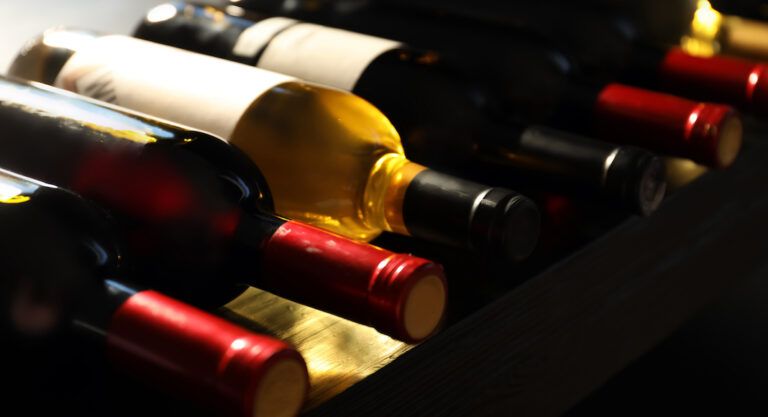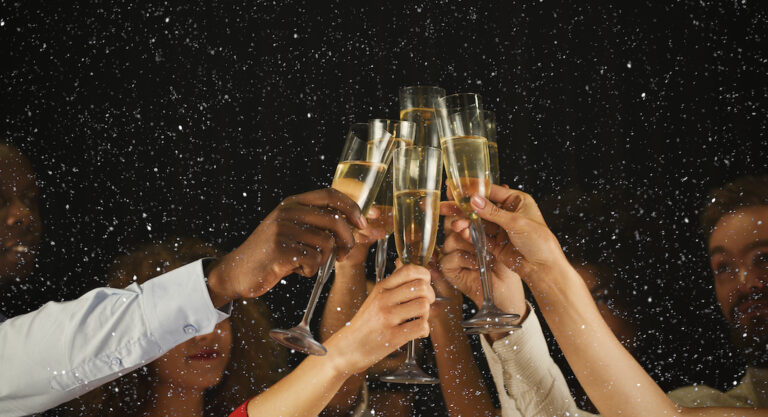Someone got engaged? CHAMPAGNE! New Year’s Eve? CHAMPAGNE! New baby? CHAMPAGNE (for everyone except the mother)!
Champagne is the confetti of drinks–it’s only to be brought out on special occassions. So when you do buy, pop, serve, and drink champagne, you better do it right, because if you mess up, you have to wait for another celebration to redeem yourself. Our champagne guide will help you know what to look for, and how to enjoy France’s most famous beverage.
The Basics of Champagne
What is champagne?
Champagne is a sparkling (carbonated) wine that can be made from seven different types of grapes: Chardonnay, Pinot Meunier, Pinot Noir, Arbane, Petit Meslier, Pinot Blanc, and Pinot Gris. Champagne is usually distinguished by toasty brioche notes, high acidity, and a dazzling effervescence. Champagne production involves two rounds of fermentation to carbonate it (with the second fermentation process in the bottle), and it takes a legal minimum of 18 months to make, though a good Champagne will take at least three years.
What’s the difference between sparkling wine and champagne?
Legally, as with all French wines, a champagne must come from the Champagne region, but colloquially when Americans say “champagne” we’re often talking about any kind of sparkling wine. Essentially, all champagnes are sparkling wines but not all sparkling wines are champagnes.
In America, we have Bordeaux from California and Chablis from South Carolina. However, according to several historical treaties, we shouldn’t be allowed to do that. After some pressure from the E.U. and the International Champagne Committee, the U.S. passed a law in 2006 banning the use of the word “champagne” (and the names of several other French region-based wines) on any American-brand wine made after March 2006. All brands existing before March 2006 can continue to call their California bubbly “champagne.”
What grapes are used in champagne?
Chardonnay is not just a wine, it’s also a type of grape used in the making of champagne. The three most popular types of grapes used to make champagne are chardonnay (white grapes) from Burgundy, pinot meunier (black grapes) from Champagne, and pinot noir (black grapes) from Burgundy.
How to read a champagne label
Real Champagne comes from the wine region of Champagne, and should say “Méthode Champenoise” (“Champagne Method”) on the label. (This style is also called the traditional method, or méthode traditionnelle, when referring to sparkling wine made outside of Champagne.) Vintage Champagne with a year next to it means the grapes from that harvest during that year were excellent and used to make that champagne. If there’s no “vintage” with a year, the champagne was made using grapes from multiple years and is called an N.V. (Non-Vintage Champagne).
The sweetness of a champagne is classified by how much sugar is present in grams per liter. In order of least sweet to sweetest: brut nature/brut zéro (fewer than 3g/L), extra brut (fewer than 6g/L), brut champagne (fewer than 15g/L), extra sec/extra dry (12-20g/L), sec (17-35g/L), demi-sec (33-50g/L), or doux (more than 50g/L). If it is “blanc de blancs” champagne, then it is made from only chardonnay grapes. If the champagne is “blanc de noirs” then it’s made from pinot meunier and/or pinot noir grapes. Rosé champagne, which is generally less sweet, is often made from black grape varieties like Pinot Noir or Pinot Meunier.
Ordering Champagne in a Restaurant
How to order champagne in a restaurant
The most famous champagnes are from the great champagne houses of Moët & Chandon, Dom Pérignon, and Veuve Clicquot. But there are hundreds of smaller producers that make champagne that is just as good, if not better. Consider a champagne house like Jeeper, Bollinger, or Barons de Rothschild, for something a little more unique.
Which champagne should I drink?
Sommeliers are the keepers of knowledge. They taste the wines and develop the wine list. They know it perfectly. Tell them you “want to spend something in this *points to a price on the menu* range.” Tell them what you’re ordering for dinner. Tell them about the flavors you like. Trust them.
How champagne is served
Because there’s a bucket of ice, water, and condensation involved, there’s a court dance of silver and crystal before and during the arrival of the champagne. The sommelier will show you the champagne and say the name (and its vintage, if applicable). Confirm it’s the right bottle, and they’ll pop the cork. The cork will be set down next to the person who ordered the champagne. The person who ordered the champagne will be poured a taste. If it tastes like it’s has been corked (gone bad), the sommelier will retrieve a new bottle. (Note: tasting the wine is not to ensure that you like the wine, but to determine if it has gone bad. You don’t get to send back a freshly corked bottle of champagne just because it isn’t to your liking.) If the wine is good, the sommelier will serve the rest of the party. The person who ordered the champagne may be asked if they want the cork or not. Saying no is fine. The person who ordered the champagne may also be asked how they want the temperature of the champagne—chilled or room temperature. Champagne is better cold so keep the ice bucket.
Tasting the champagne
Champagne needs no swirling, as it’s already aerated from the bubbles, and champagne flutes are designed to keep those bubbles intact by limiting contact with the air. Simply look at your champagne—the bubbles should be small, the color bright. Smell it, it should be fragrant. Sip it, feel it in your mouth, then swallow.
Discussing the flavor of champagne
The most inexperienced consumers will raise their eyebrows and say, “mmm”, but Frenchly encourages you to do better. Terroir, an untranslatable French word referring to the environmental impact of a place on its products, plays an enormous role in the flavor of champagne. Champagne is generally quite dry and highly acidic, with aromas of bread and baked goods. Younger champagnes often have notes of green apple or citrus, while slightly older champagnes may have notes of stone fruits (peach, apricot, prune). If the champagne is old enough, it can take on nutty and baked fruit flavors. The oldest champagnes may have notes of things like cocoa, coffee, and mushroom.
How to Drink Champagne at Home
At what temperature should you serve champagne
Chilled but not cold. If it’s too cold, the flavor is lost. About three hours in the fridge, or on ice for 30 minutes is fine. It heats quickly in the glass, so don’t wait more than a few minutes to toast and drink. Once open, keep the bottle in a bucket of ice water.
How to open champagne
When done right, you won’t look like an idiot. First hold the bottle up and look at the label. Read it. (This isn’t necessary, but you’ll look intelligent doing it.) Remove the foil from the wire cage around the cork. Set your hand on top of the cage and cork. At the bottom of the exposed cage is a circle of wire—twist it to loosen the cage. One hand around the cage and cork, hold the base of the bottle with your other hand at a 45-degree angle away from people, pets, and fragile things. Twist the base of the bottle back and forth. The pressure forming in the bottle will push the cork out. If you are careful enough, it won’t even make a popping sound. This is how a professional sommelier would open champagne, but we think a little pop is half the fun.
Sabering champagne
If your masculinity, curated artistic persona, or reputation at work depends on your ability to wield a knife and slice off a cork and glass stem, by all means, saber away. Do it away from everyone, and check the sabered part to make sure it breaks cleanly, without leaving shards of glass on the floor. For the bravest, here’s a video about how to saber.
Serving champagne
There are plenty of disagreements among experts as to what kind of glass is best for champagne. Many swear by the coupe, which allows you to take in more of the aromas of the sparkling wine. Drinking from a larger glass, however, causes the bubbles to disappear faster. This is why others prefer a flute or tulip glass, which hold in bubbles, but restrict the wine’s aromas. Hold both the tulip glass and champagne at an angle, and pour the champagne slowly down the side of the glass. Stop pouring when the forming foam nears the top, wait for the foam to settle, then continue pouring.
How to toast in French
In France, at the end of a toast, or the beginning of a dinner, everyone holds up their glass and says “Santé” or “Tchin-tchin.” Remember to make eye contact with everyone involved in the toast, or it’s considered bad luck.
How to store champagne
The best thing to do is either buy your champagne and drink it a few hours later, or stick it in the basement where it’s away from all light, in a cool place, stored horizontally. (Champagne corks always want to be in contact with the wine.) Once it’s open, consume it quickly. If you have to save it because you didn’t drink it all, don’t put the stopper in too tightly—the trapped carbonation could cause the bottle to explode. And definitely don’t suction-seal it, because that removes the carbonation.






